

Fully supporting workforce health requires more than just offering health benefits. Tackling social drivers of health — like access to healthy food, safe housing, and financial stability — is another meaningful way to invest in employees’ long-term well-being. Addressing those basic needs can help improve workers’ lives — and your bottom line. And when employers demonstrate that decisions are made with equity in mind, it helps build a culture of trust and productivity at work.
Each year, health inequities create nearly $320 billion in health care costs and $42 billion in lost productivity.1
Society is gathering momentum to fight inequities, but tangible solutions can be hard to find. Some health systems have started assessing social health needs during office visits and making care recommendations based on that information.

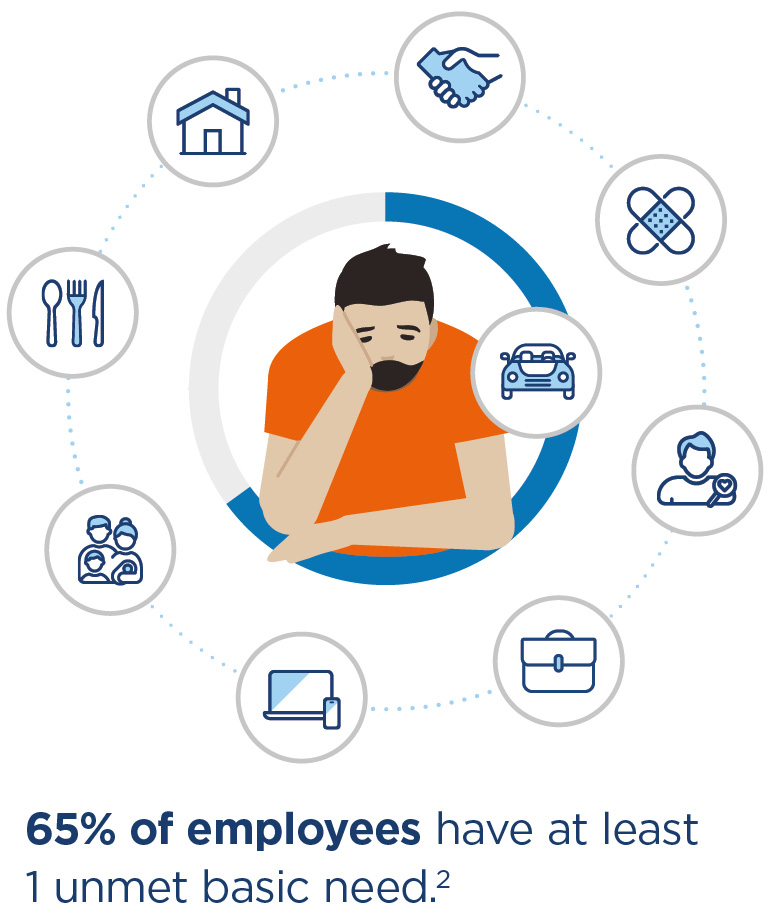
The impact of unmet social needs on your workforce
Health inequities are differences in health status based on multiple factors, including the social drivers of health. People with economic and social disadvantages often have worse health outcomes. In other words, where people are born, live, and work can affect their health more than their medical care — by as much as 80%.3
“What we’re tethering to lately has been ZIP code. We know it’s more important in some cases than your genetic code. We have to level-set our expectations based on where folks live. Adding that ZIP code to a person’s medical assessment and asking questions related to it are really powerful.”
—Shari Chevez, MD, pediatrician at Kaiser Permanente Normandie North Medical Office in Harbor City, California

Employees are struggling with the high cost of living
Many unmet social health needs are related to finances, but that doesn’t mean only low-income workers are at risk. Workers throughout your organization may experience the impact of inflation or financial pressures to varying degrees. You’ve likely experienced sticker shock at the price of eggs or gas. Remember that if your employees are struggling to make ends meet, they’re not able to give their best at work.
- 60% of U.S. adults, including more than 4 in 10 high-income consumers, live paycheck to paycheck.4
- 30- to 59-year-olds have $26,000 average in nonmortgage debt — like credit cards, auto loans, student loans, and medical bills.5
- Child care costs average more than $10,000 a year.6
- The number of adults who say they sometimes don’t have enough to eat is up 23% since the beginning of the pandemic.7
Employees who are facing financial struggles may need to make difficult decisions that could ultimately harm their health — like delaying health care, cutting back on medications, and eating cheaper, less healthy food. Employers that provide benefits and rewards to support social health, alongside physical and mental health, help lift the burden for these employees.
How can employers reduce the impact?
While you can’t influence every aspect of your employees’ lives, you can help balance inequities that affect health care costs, engagement, and retention.
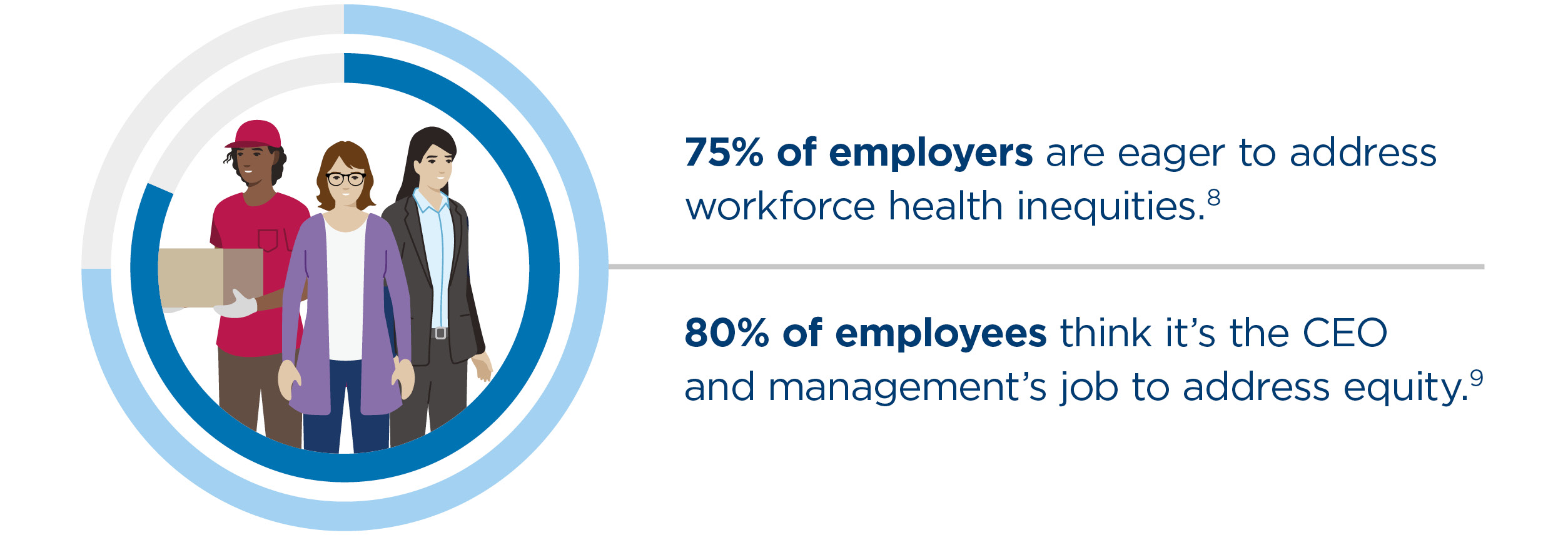
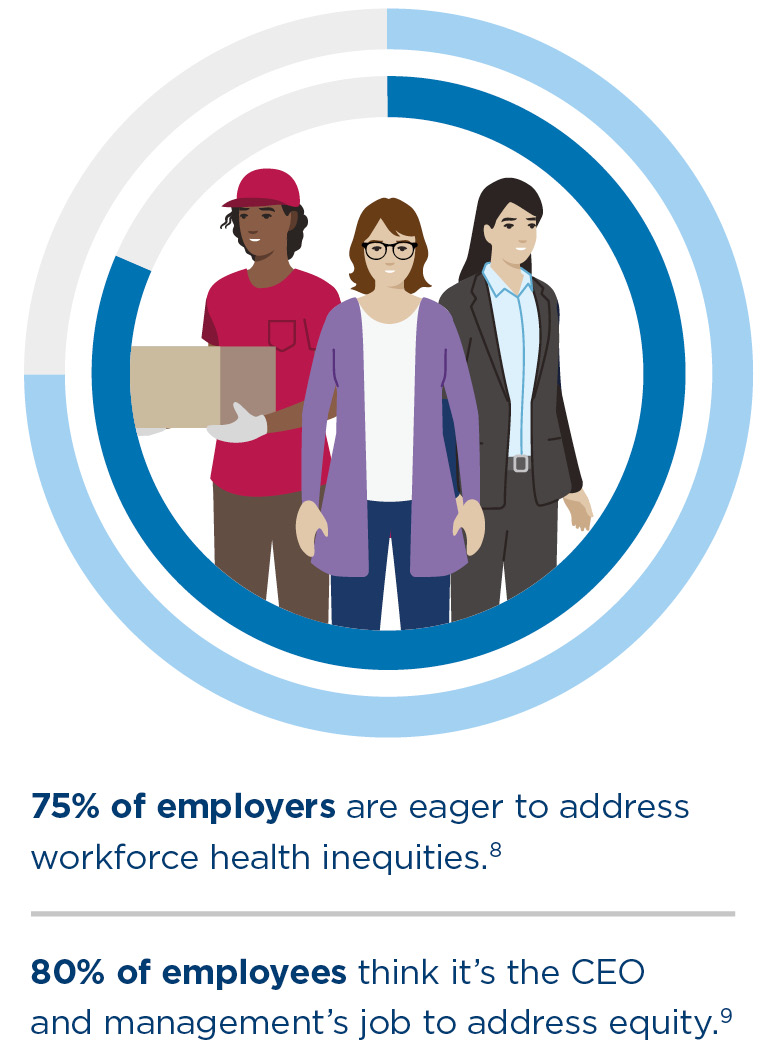
Data — the key to unlocking health equity
To ensure you’re not leaving some employees behind, you must first understand the data behind health disparities and specific social needs among your workforce. It’s essential to know:
- Demographics (race, ethnicity, gender, age)
- Health conditions and clinical usage by demographic (de-identified by your health plan)
- Social determinants of health (health care, food security, transportation, housing stability, education, financial stability, physical safety, social connections, technology access, and child/elder care)
Though the relationship isn’t always obvious, the factors of an employees’ personal life are inextricably linked to their workday. To stay focused and productive, they must be able to meet the basic needs of themselves and their families.


Collecting the data
Your company can collect data on its own or work with your health plan. With data, “The invisibility of inequality becomes more visible,” Dr. Chevez says.
- Independent evaluation
The HERO Scorecard . external link is a free, online tool that shows employers how their workforce health programs compare with industry best practices. Employers use the HERO Scorecard to help with benchmarking, strategic planning, and evaluating success.
. external link is a free, online tool that shows employers how their workforce health programs compare with industry best practices. Employers use the HERO Scorecard to help with benchmarking, strategic planning, and evaluating success. - Health plan
Your provider should be able to help you identify inequities and possible solutions. Look for a health care partner that can show clinical utilization alongside demographics and how your results compare to national benchmarks. Seeing which groups within your workforce are getting preventive care, being treated for chronic conditions, engaging with benefits programs, etc., can help you develop strategies for closing those gaps.

Using social determinants of health data to address inequity
Once you know more about who your employees are, you can develop benefits for their unique needs. Whether you start with the greatest needs or the easiest solutions, remember that even small changes can have a big impact.
Here are some inspiring programs companies have introduced by following the data:
- On-site wellness centers — Care for employees and their families at work. At each visit, the employee is asked to take a social health assessment to discover their needs and connect them to company benefits or community resources
 . external link
. external link
- Solves for: Shift flexibility, sick time, copay costs, transportation, childcare
- Digital resources — Company smartphones and data plans for lower-income workers.
- Solves for: Low virtual care engagement due to lack of home internet
- Financial hardship funds — Advances from future paychecks to cover certain expenses, such as car repairs and rent.
- Solves for: Transportation, housing, temporary 401(k) loans
- Work shuttles — Corporate buses shuttle employees between certain neighborhoods and work.
- Solves for: Transportation, safety, finances
Making your programs successful
Even the best programs can’t make an impact unless employees participate. To boost engagement, it’s important to work on awareness, education, and navigation.

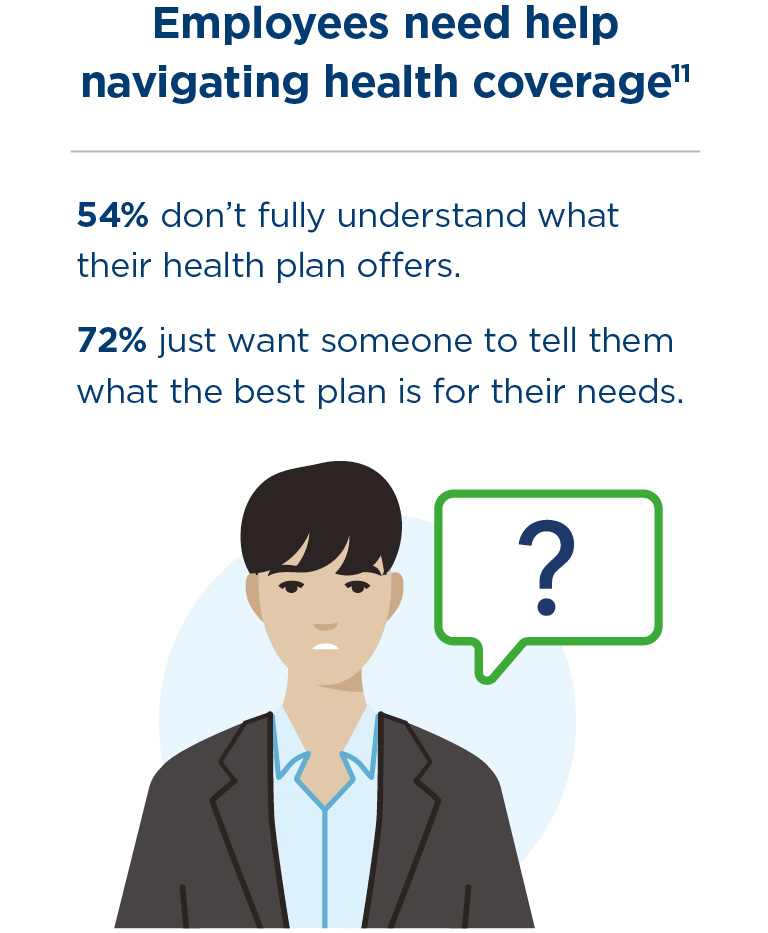
Promote awareness
Normalize the need for social health programs![]() . external link — and embed support for total health into your culture and encourage employees to participate.
. external link — and embed support for total health into your culture and encourage employees to participate.
- Post flyers in common areas and update them annually.
- Send reminder emails, each with space devoted to an aspect of your social health program.
- Have managers share resources during team meetings.
Provide education
Empower your employees to make informed health decisions.
- Review health plan coverage and other opt-in programs like savings and spending accounts during onboarding and annually ahead of open enrollment.
- Send surveys before open enrollment asking employees what they need to make their choices.
- Share educational resources with your employees’ partners and dependents.
- Create translated materials for employees whose preferred language isn’t English.
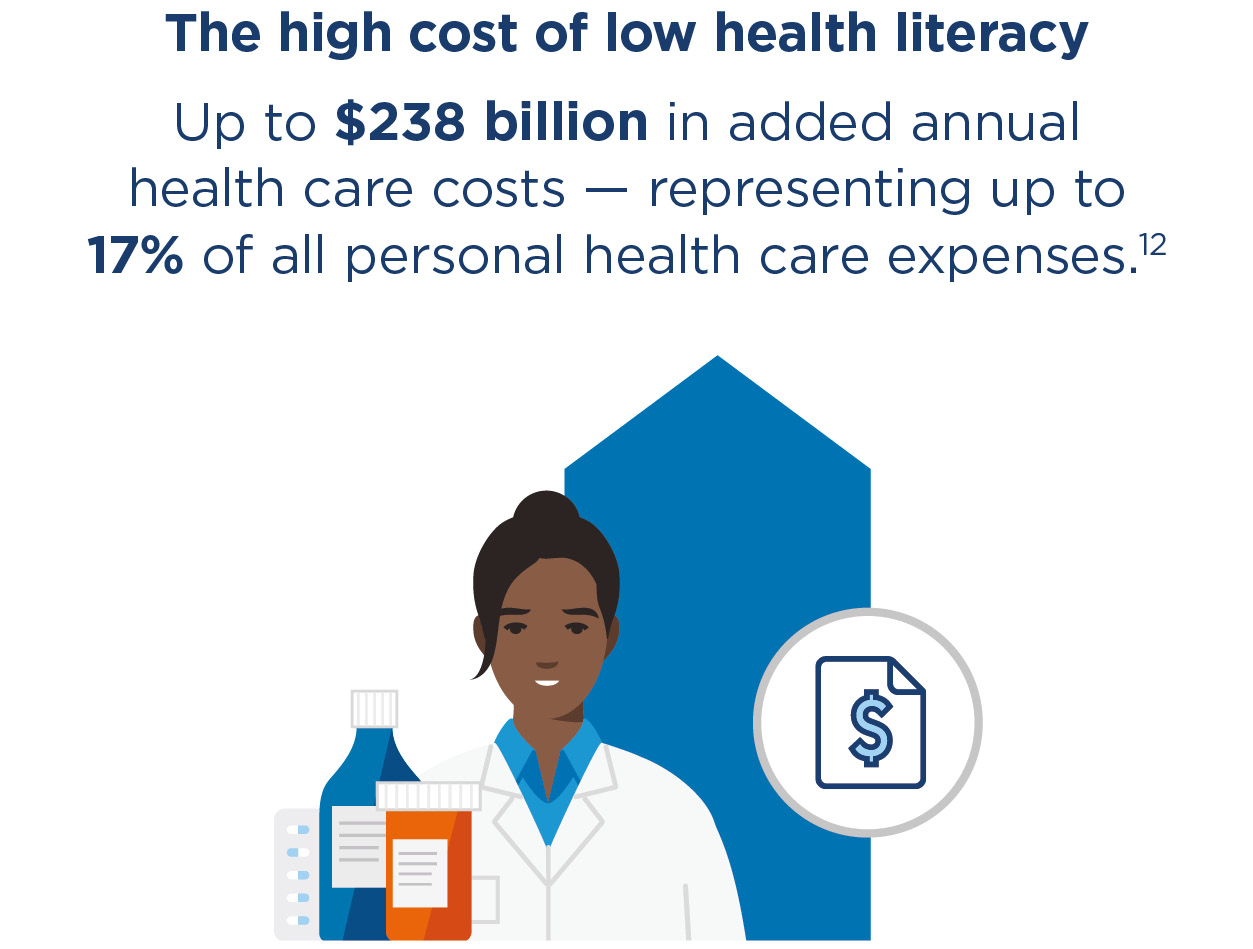
Help with navigation
Make programs easy to sign up for and use.
- Tap employee ambassadors to help fellow workers understand their benefits.
- Offer incentives for participation in benefits education, wellness assessments, or preventive screenings.
- Accommodate flexible scheduling so people can care for their families and themselves in a timely manner.
Improving social health to achieve equity
Many employers are eager to find solutions to inequities, but getting started can feel overwhelming. Gathering social determinants of health data — on your own or with your health plan — will give you a clearer picture of your employees’ health experience. The strategies you surface can help move the needle toward a more equitable future for your employees, their families, and the communities where they live and work.
About our expert

Dr. Chevez is a pediatrician at Kaiser Permanente Torrance Medical Offices. She’s also the regional assistant area medical director and physician chair for equity, inclusion, and diversity — helping to incorporate those values into health care at Kaiser Permanente, the workplace, and in the community. She earned her medical degree from Stanford University School of Medicine. In her free time, Dr. Chevez loves reading biographies, traveling, nature walks, and spending time with her son, Luke.
Resources you may find helpful
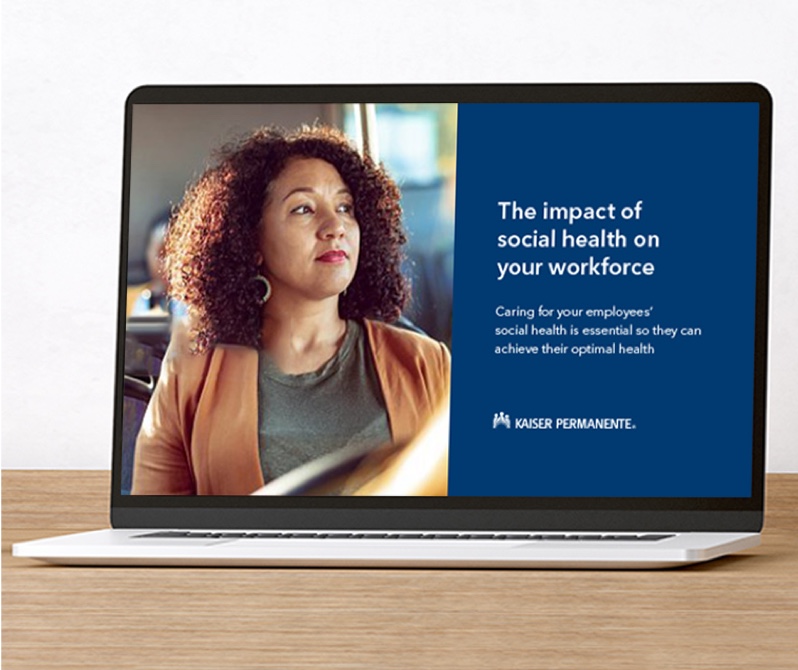


- 1
1Andy Davis et al., “U.S. Health Care Can’t Afford Health Inequities,” Deloitte Insights, June 22, 2022.
- 2
Jenny Cordina et al., “Income Alone May Be Insufficient: How Employers Can Help Advance Health Equity in the Workplace,” McKinsey & Company, December 3, 2021.
- 3
County Health Rankings model, University of Wisconsin Population Health Institute, accessed July 25, 2023.
4New Reality Check: The Paycheck-to-Paycheck Report, PYMNTS and LendingClub, February 2023. - 4
Bill Fay, “Demographics of Debt,” Debt.org, July 21, 2023.
- 5
Christin Landivar, “New Childcare Data Shows Prices Are Untenable for Families,” U.S. Department of Labor Blog, January 24, 2023.
- 6
Household Pulse Survey, U.S. Census Bureau, accessed July 25, 2023.
- 7
2023 Large Employers’ Health Care Strategy and Plan Design Survey, Business Group on Health, August 23, 2022.
- 8
Racial Justice and Equity Survey, Benevity, June 17, 2021.
- 9
See note 2.
- 10
2022 Health Insurance Knowledge Snapshot, Justworks and Harris Poll, August 4, 2022.
- 11
Rabia Shahid et al., “Impact of Low Health Literacy on Patients’ Health Outcomes: A Multicenter Cohort Study,” BMC Health Services Research, September 12, 2022.
Kaiser Permanente health plans around the country: Kaiser Foundation Health Plan, Inc., in Northern and Southern California and Hawaii • Kaiser Foundation Health Plan of Colorado • Kaiser Foundation Health Plan of Georgia, Inc., Nine Piedmont Center, 3495 Piedmont Road NE, Atlanta, GA 30305 • Kaiser Foundation Health Plan of the Mid-Atlantic States, Inc., in Maryland, Virginia, and Washington, D.C., 2101 E. Jefferson St., Rockville, MD 20852 • Kaiser Foundation Health Plan of the Northwest, 500 NE Multnomah St., Suite 100, Portland, OR 97232 • Kaiser Foundation Health Plan of Washington or Kaiser Foundation Health Plan of Washington Options, Inc., 1300 SW 27th St., Renton, WA 98057
Congratulations! You have successfully saved this item.
To access your Saved items any time, open the "Saved Items" folder in the top right corner of the page.
It seems that you do not have cookies enabled. Please enable cookies to make use of all of our site's functionality.
You haven't collected any items yet.
- Save Content
Click the "Save" icon next to the content you want to revisit later.
- Access Your Saved Items
Click on the "Saved Items" link at the top of the page or use the URL we create for you.
Be sure to copy and paste the URL we create for you before you leave the site.
1-5 of 14
Your Link
After leave the site, your saved items will be saved for you at this URL:
https://business.preview.dpaprod.kpwpce.kp-aws-cloud.org/saved-items?user=Share your list
Show Disclaimer +


